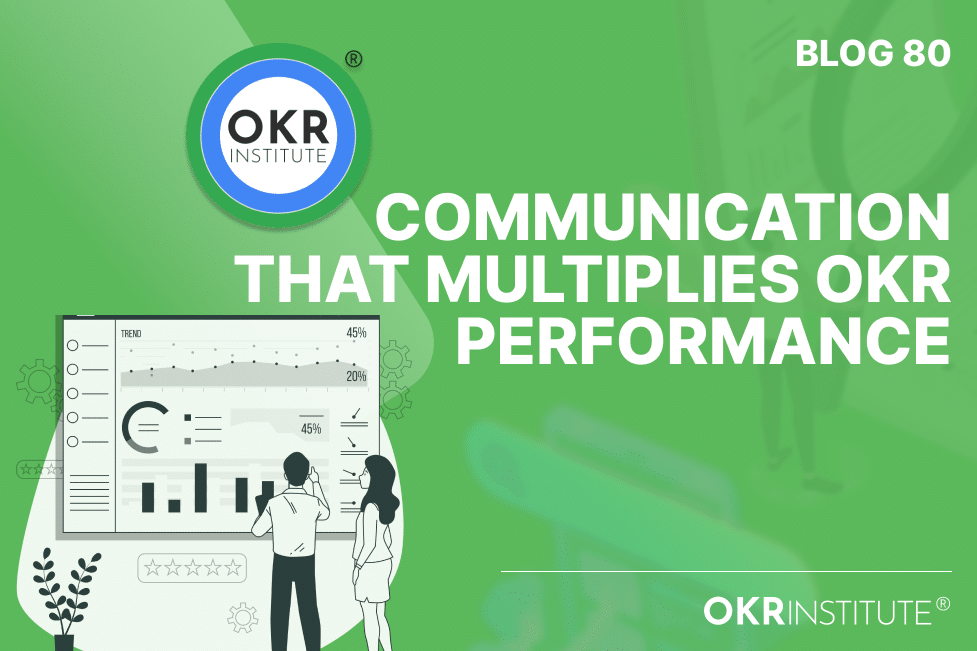Communication that multiplies OKR performance

Communication that multiplies OKR Performance
Successful negotiation is about something other than getting to ‘yes.’ It is about mastering ‘no’ and understanding what the path to an agreement is
Chris Voss
Townhalls, weekly check-ins, coaching sessions and reviews are all ‘touch points’ that we can utilize to communicate the following:
- Reason for deploying OKRs (our Why)
- The impact on our customers, clients or users that we are creating through OKRs and the true value added to them
- Opportunity to iterate and improve
- Urgency and importance of what we are doing
- Top priorities of the company
- company Vision and strategies with a high degree of transparency
- Successes that we have achieved, as well as the learnings from our mistakes
Through mostly positive, open and collaborative communication we can create a motivating climate that makes it simpler for team members to perform and understand the impact of their roles.
To create positive outcomes through meetings, a core need is to collaborate toward agreements on the next steps, what we should avoid, and what we should improve upon. Positively and jointly questioning our status quo as a team and communicating the areas of focus toward continuous improvement followed by action and iterations creates a path toward achieving excellence.
Our Priorities should be reflected in our communication in a transparent way. At the heart of prioritization is the careful consideration of what we should say no to and what we should say yes to.
Communications Planning – Usually the missing link
A high-quality OKR strategic roll-out plan can form the foundation for a successful and sustainable OKR roll-out. However, the strategic roll-out plan needs to include a communications plan.
To support a succesful roll-out a communications plan can elaborate on:
- The ideal frequency of communication (e.g weekly check-ins)
- What reminders needs to be sent out (and who is responsible for sending them)
- How to foster collaboration through communication
- The communications training required to ensure effective internal coaching sessions
- A contact list of all the various OKR participants
Leadership starts with Inspirational Communication
High levels of Inspiration are required to achieve far-reaching goals. Team members tend to follow what Leaders and managers focus on. Through a strong focus on a compelling vision, transparent and meaningful strategies, inspirational communication, and leading by example, leaders can influence OKR team performance.
Excellent OKR communication focuses on:
- Clarity of Vision
- Co-created and clear strategies
- Belonging cues to help build Psychological safety (Sincere cues , such as ‘Your contributions are valuable to the team’)
- I am asking positive questions that foster collaboration over preparing long speeches. (How can I better support you? What is it that we can do better?)
- Priorities ( We need to define what to say yes to and what to say no to)
Getting your team to Discuss and agree to a summary is way more powerful than a ‘yes’
It is an ‘OKR Communication’ best practice to create a short meeting summary at the end of the meeting. This summary can make the following benefits-
- It serves as a reminder of what was said during the meeting.
- It is an oppurtunity to distill what was said into action points
- Getting an agreement to the summary after a discussion is more powerful than an individual doing all the talking and the rest simply agreeing by constantly saying yes to everything.
Often, meetings have low value, especially when no clear and focused agenda is aligned to outcomes and there is no summary agreement or clarified action steps.
Summary
‘OKR communication’ fosters collaboration through the positive and collective questioning of the status quo. ‘OKR Communication’ should also reflect priorities and be aligned with a compelling vision and purpose. A communications plan is generally an excellent supplement to a strategic OKR Roll-out plan.
‘OKR communication’ is the glue that holds the implementation of Objectives and key results frameworks together.
FAQs for “Communication that Multiplies OKR Performance”
Why is communication important for OKR implementation?
Effective communication is crucial for OKR implementation because it ensures that everyone understands the purpose behind the OKRs, the impact they have on customers, and the value they add to the organization. Regular touch points such as townhalls, weekly check-ins, and coaching sessions help keep everyone aligned and motivated, making it easier for team members to understand their roles and contribute to the company’s goals.
What should be included in an OKR communications plan?
An OKR communications plan should include the ideal frequency of communication (e.g., weekly check-ins), reminders and responsible parties, strategies for fostering collaboration, necessary communications training, and a contact list of all OKR participants. This plan ensures that communication is consistent, transparent, and aligned with the overall strategic roll-out of the OKRs.
How can leaders inspire their teams through OKR communication?
Leaders can inspire their teams through OKR communication by focusing on clarity of vision, co-creating clear strategies, and using sincere belonging cues that build psychological safety. Inspirational communication involves asking positive questions that foster collaboration, prioritizing tasks effectively, and leading by example. This approach helps create a motivating environment where team members feel valued and driven to achieve far-reaching goals.
What are the best practices for effective OKR meetings?
Effective OKR meetings should have a clear and focused agenda aligned with outcomes, include discussions and agreements on action steps, and conclude with a short meeting summary. This summary serves as a reminder of what was discussed, distills key points into actionable items, and ensures agreement among participants, making the meeting more valuable and productive.
How can a company ensure continuous improvement through OKR communication?
Continuous improvement through OKR communication can be achieved by collaboratively questioning the status quo, identifying areas of focus for improvement, and iterating on action steps. Transparent communication about priorities, successes, and learnings from mistakes helps teams stay aligned and motivated, fostering a culture of continuous improvement and excellence.
Talent Development Director of the OKR Institute
Related Courses
Recent Posts
Tags
#OKR
#OKR Coaching
#OKR Coach







